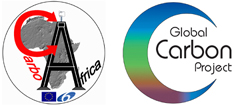Estimating carbon emissions from African wildfires
Abstract. We developed a technique for studying seasonal and interannual variation in pyrogenic carbon emissions from Africa using a modelling approach that scales burned area estimates from L3JRC, a map recently generated from remote sensing of burn scars instead of active fires. Carbon fluxes were calculated by the novel fire model SPITFIRE embedded within the dynamic vegetation model framework LPJ-GUESS, using daily climate input.
For the time period from 2001 to 2005 an average area of 195.5±24×104 km2 was burned annually, releasing an average of 723±70 Tg C to the atmosphere; these estimates for the biomass burned are within the range of previously published estimates. Despite the fact that the majority of wildfires are ignited by humans, strong relationships between climatic conditions (particularly precipitation), net primary productivity and overall biomass burnt emerged. Our investigation of the relationships between burnt area and carbon emissions and their potential drivers available litter and precipitation revealed uni-modal responses to annual precipitation, with a maximum around 1000 mm for burned area and emissions, or 1200 mm for litter availability. Similar response patterns identified in savannahs worldwide point to precipitation as a chief determinant for short-term variation in fire regime. A considerable variability that cannot be explained by fire-precipitation relationships alone indicates the existence of additional factors that must be taken into account.






